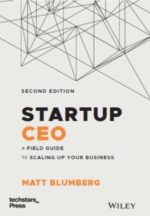Opportunity Knocks
Opportunity Knocks
When our friends at Habeas announced that they were exploring a sale of the company a few months back, we were intrigued. While fiercely competing in the marketplace does create some degree of tension or even mistrust between two companies, that activity also creates a lot of common ground for discussion about the market and the future.
So we are very excited today to announce that we are acquiring Habeas in a deal that is signed and should close within a couple weeks. Cutting through all the PR platitudes, here’s what this deal really means for our stakeholders:
For everyone we work with, this deal means we have even more scale. More scale is a good thing. It means we can invest more in our future in everything from technical infrastructure, to product innovation, to globalization, to employee development. It’s easy to be great when you’re a 25 person company. It’s actually quite challenging when you’re a 50-100 person company. It becomes easier again, though in different ways, when you are a 200 person company with more resources.
For ISPs and filters, more scale means more and better data products to help fine tune filtering algorithms and improve member experience. It also means an even more streamlined way to reach masses of marketers and publishers.
For sender clients, we can now offer expanded service levels and access to a broader “footprint” of ISPs and filters who subscribe to our services. The consolidated company will be one step closer to providing a universal set of standards for measuring sender-focused email quality and reputation. Some of the details still need to be worked out here, so look for more specific communication from your account representative in the coming weeks. The one thing we do know at this point is that we will be maintaining both Sender Score Certified and the Habeas SafeList as separate and distinct whitelist programs indefinitely. So for now, it’s business as usual.
For employees, combining the resources of the two companies means we will be in a better position to wow our clients. A bigger employee base and a larger company also means more career opportunities for all.
We have always been mindful that, even as the market leader, we have to earn “every dollar, every day” from our clients, and we have to constantly demonstrate to ISPs and filters that we are not just advocating for our sender clients but for them and their subscribers as well. None of that changes with this deal. We still have plenty of competition and are redoubling our efforts to lead the market with innovation and service levels, not just with size and scale.
Our friend Ken Magill wrote some unkind remarks about Habeas a while back. At the time, as fierce competitors with Habeas, we probably agreed with him. But as we’ve gotten to know Habeas better over the past few weeks, we realized what a great business the Habeas team has built in the last five years — including: a strong customer base and partner network, innovative reputation technologies, complementary receiver and data partnerships and most importantly, an incredible team of people as fanatical about saving email as Return Path. For Return Path employees and clients, we get access to these new assets that now makes us an even stronger leader in this space. And Habeas employees and clients now have expanded access to great resources and talent from Return Path. But the big winners are the ISPs, filters, and email senders – they will l now have access to a more universal solution to deliverability and filtering accuracy.
So, to Habeas’ employees, we say “Welcome to the Return Path family!” We are delighted to have you and look forward to many years of success together. As I said to my wife when we were in the middle of all the due diligence on the deal, “learning more about Habeas is a little bit like looking in one of those Fun House mirrors at a carnival – you see yourself, just looking slightly different.” We will all have to work together to move to the common ground from the prior world of competing against each other, but the exciting future of the business and the industry will propel us there.
Onward!
Book Short: Catchiest Title in a Long Time
Book Short: Catchiest Title in a Long Time
You have to admit, a book called The 4-Hour Workweek: Escape 9-5, Live Anywhere, and Join the New Rich has a pretty enticing title. The email geek in me thinks that if it were a subject line, it would have a good open rate. Anyway, the book, by Timothy Ferriss, is a breezy read that blends self help with entrepreneurship, has a lot of good resource lists in it, and is worth reading if you don’t take it too seriously.
There are some good central points to the book. First, life has changed, and people don’t want to slave away until they’re 65 any more so they can do all the fun stuff in their old age — they want to change directions, unplug more regularly, and enjoy life with their families when they’re younger. I buy that.
Second, good companies are increasingly allowing employees more degrees of freedom in the where and when and even how of getting things done, just as long as they get things done — and people should take advantage of that. I buy that as well — we practice that at Return Path, generally speaking. Third, startups that are mainly virtual organizations and internet-based are easier, cheaper, and potentially more profitable than most businesses have been, historically speaking. Ok, fair enough.
Fourth, anyone can be just like the author and do all of this stuff, too, right? Start a business that turns into a cash machine that requires little to no maintenance while becoming one of the best tango dancers in the world in South America, etc. etc. etc. Well, maybe not. I guess the point of self-help books is to show an extreme example and inspire people to achieve it, and I do think there’s a lot to what Ferriss says about how people can live richly without being rich, but the fact is that the world would fall apart if everyone did what he does. And the other fact is that Ferriss is well above average in intellect and drive, and probably some physical talents as well from his descriptions of tango dancing and kick boxing, which must contribute to his success in life far more than his operating philosophy does.
But as I said, it’s a fun read, and if you don’t take it too seriously, or at least take the feedback directionally as opposed to whole hog, it’s well worth it.
Curbing My Enthusiasm
Curbing My Enthusiasm
For the first time since I started blogging over four years ago, I have recently run into several examples in a short period of time where I’d love to blog about something happening in the business, and I think it would make for a great blog posting, but I can’t do it. Why can’t I? Lots of different reasons:
– Don’t want to telegraph strategy to the competition
– Don’t want to compromise an employee (current or former)
– Worried about downstream legal ramifications
There are other reasons as well, but these are the main three. I love transparency as much as the next person (and more than most), but these scenarios have to trump transparency in my position as a CEO. Hopefully the passage of time and the release of news will mean that I can still do the blog postings, but as more of a post mortem than something in the moment.
But I hate curbing my own enthusiasm. It’s a definite frustration in this case, and a new one.
Book Short: On The Same Page
Book Short: On The Same Page
Being on the same page with your team, or your whole company for that matter, is a key to success in business. The Four Obsessions of an Extraordinary Executive, by Patrick Lencioni, espouses this notion and boils down the role of the CEO to four points:
- Build and maintain a cohesive leadership team
- Create organizational clarity
- Overcommunicate organizational clarity
- Reinforce organizational clarity through human systems
Those four points sound as boring as bread, but the book is anything but. The book’s style is easy and breezy — business fiction. One of the most poignant moments for me was when the book’s “other CEO” (the one that doesn’t “get it”) reflects that he “didn’t go into business to referee executive team meetings and delivery employee orientation…he loved strategy and competition.” Being a CEO is a dynamic job that changes tremendously as the organization grows. This book is a great handbook for anyone transitioning out of the startup phase, or for anyone managing a larger organization.
I haven’t read the author’s other books (this is one in a series), but I will soon!
Book Short: On Employee Engagement
Book Short: On Employee Engagement
The first time I ever heard the term “Employee Engagement” was from my colleague David Sieh, one of the better managers I’ve ever worked with. He said it was his objective for his engineering team. He explained how he tried to achieve it. I Quit, But forgot to Tell You, by Terri Kabachnick, is a whole book on this topic, a very short but very potent one (the best kind of business books, if you ask me).
It’s got all the short-form stuff you’d expect…a checklist of reasons for disengagement, an engagement quiz, the lifecycle of an employee that leads to disengagement, rules for dealing as a manager.
But beyond the practical, the book serves as a good reminder that employee engagement is the key to a successful organization, no matter what industry you’re in. All managers at Return Path — this is on the way to your desk soon!
Most scenic airport. Ever.
Most scenic airport. Ever.
If all business travel started or ended like this (Jackson Hole), the world would be a happier place, I’m certain.
Why Do People Behave Like Jackasses Online?
Why Do People Behave Like Jackasses Online?
I won’t disclose the name of the person who did this, but here’s the chain of events:
- Person registers for our Postmaster Direct service to receive targeted offers via email. This is a closed-loop, double opt-in registration process (so the person had to register and then click on a confirmation email)
- Person receives a handful of relevant, targeted offers from us
- Person finds my name on our corporate web site and messages my wife on Facebook to tell her that her husband is a dirty spammer who needs to learn a lesson, and would she please make him and his company behave?
- Person finds my blog and comments on it saying “don’t give return path any email addresses, they spam the crap out of you. I’ve already filed a complaint with the BBB. If this doesn’t work, I’ll have to use some unorthodox means of getting their attention.” As if said person hadn’t already used unorthodox means of getting my attention
- Person finds a few other blogs on which I am mentioned, and posts similar negative personal comments
- I politely email Person back, asking him if he had tried to unsubscribe (which works) or contact our customer service email (which is manned and emptied out daily) or email me directly if he felt so inclined to remove himself from our database, remind him that we are double opt-in, and somewhat less gently tell him I thought he was out of bounds for messaging my wife on Facebook
- Person emails back, much softer tone, says he never tried to unsubscribe because he’s never had success doing that in the past
- I email back, ask for all his email addresses so I can add him to our suppression list
- He emails back, tells me that he doesn’t want to stop getting our emails, he just wants them at his Hotmail account instead of his work (.gov) account
Perhaps sometimes the anonymity of a keyboard isn’t a good thing.
Book Short: Stick Figures That Matter
Book Short: Stick Figures That Matter
I have read a bunch of books lately to try to improve my presentation skills. The latest one, The Back of the Napkin: Solving Problems and Selling Ideas with Pictures, by Dan Roam, was good, and quite different from some of the others I’ve read recently like Presentation Zen and Beyond Bullet Points, both of which are much more focused on effective use of Powerpoint.
The Back of the Napkin takes a different approach. The focus is much more on creating compelling visuals. It’s not about Powerpoint so much as it is about teaching how to crystallize concepts into tight and compelling schematics. Roam creates two pretty good frameworks for thinking about this: one that breaks down the message of a given slide into its most simple element — are you describing a who (use a portrait), what (chart), when (timeline), where (map), why (plot), or how (flowchart)? And a second that takes that element and asks five questions about the best way to convey the information — simple vs. elaborate, quality vs. quantity, vision vs. execution, individual vs. comparison, or change state vs. as-is.
Both frameworks are good, and if you’re already doing really good presentations, this will help improve them. In short, I’d say The Back of the Napkin is a good read if you’re obsessed with creating compelling visuals, but it’s more of a deeper drill than the two books I noted above. I’d read and master the material from Presentation Zen for 101, then dive into this topic for the 201 course.
Pendulum Swinging Back?
Pendulum Swinging Back?
The TechCrunch news du jour is that Jason Calacanis has stopped blogging and is instead using email to communicate with his circle.
It’s interesting to note that after months (years?) of “email is dead” stories specifically around blogging, RSS feeds, and social media in general, the pendulum seems to be swinging back to email. You should read Jason’s words yourself, but his notes are mainly that there’s too much noise and self-promotion in the blogosphere, while email promotes intimacy and efficiency.
Not surprisingly, TechCrunch is a doubter, but we’ll have to see.
Learn Word of Mouth Marketing
Learn Word of Mouth Marketing
Our friend, former RP colleague, and WOM guru Andy Sernovitz is hosting a small-group word of mouth marketing seminar. Usually he only does private training for companies at a very large price, so this is a rare chance for 50 people to get the best introduction to word of mouth that there is. I blogged about his book a while back here.
We’ve arranged for a $250 discount for our clients. Use code “welovereturnpath” when you register (kind of catchy code, isn’t it?).
This is a very practical, hands-on course. In one intense day, you will:
- Master the five steps of word of mouth marketing
- Construct an action plan that your company can start using the very next day
- Get the same training that big corporations (Microsoft, TiVo, eBay) have received — for a fraction of what they paid
- Know how to translate word of mouth marketing into real ROI
- Participate in an active, intense day of practical brainstorming (not boring theory)
- Learn from Andy Sernovitz, the guy who literally wrote the book on word of mouth marketing
Andy promises you will learn a repeatable, proven marketing framework that is easy to execute, affordable, and provides measurable results within 60 days.
More information: http://events.gaspedal.com
Chicago: July 30 and September 4
Pass it on: http://events.gaspedal.com/banners
Please, Keep Not Calling (Thank You!)
Please, Keep Not Calling (Thank You!)
It’s been three years since the federal government passed one of its better pieces of legislation in recent memory, creating the Do Not Call Registry which is a free way of dramatically reducing junk phone solicitations. At the time, registrations were set to expire every three years. When I signed up my phone number, I stuck a note in my calendar for today (three years later) to renew my registration. I was planning on blogging about it to remind the rest of the world, too.
To my great surprise, when I went to the site today, I saw this note:
Your registration will not expire. Telephone numbers placed on the National Do Not Call Registry will remain on it permanently due to the Do-Not-Call Improvement Act of 2007, which became law in February 2008.
That’s two great pieces of legislation. What will they think of next?




